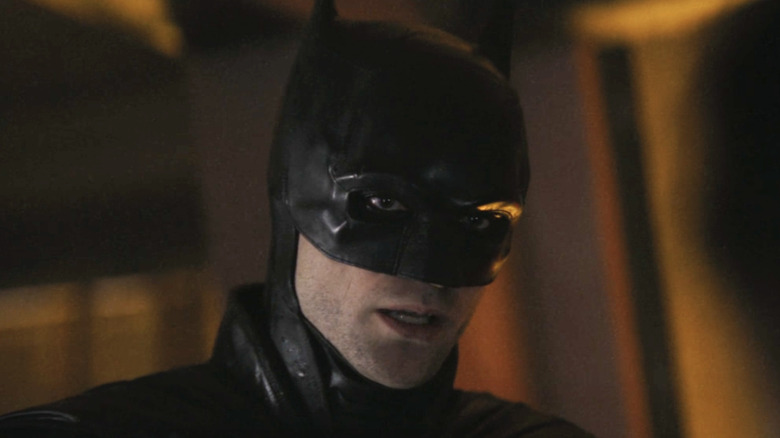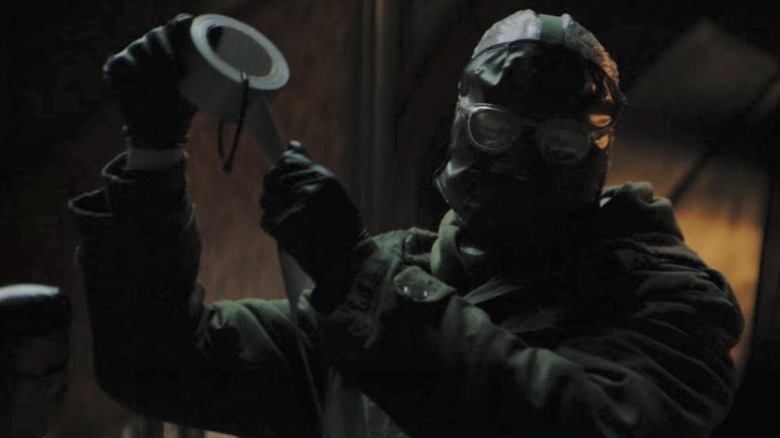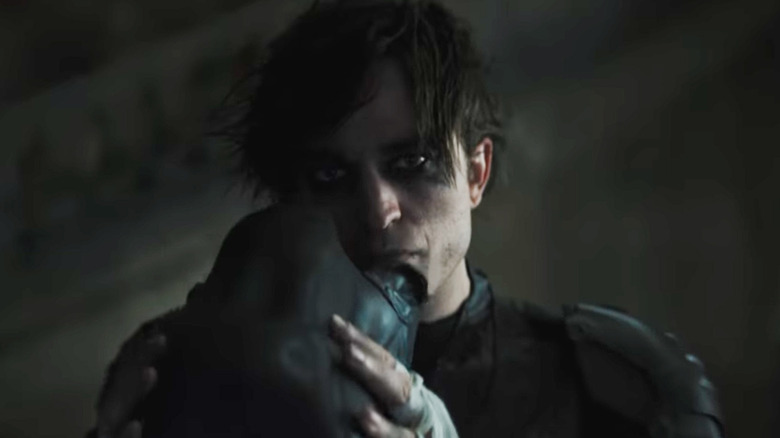Why The Batman's Unseen Arkham Prisoner Scene Means More Than You Think
Warning: this article contains spoilers for "The Batman."
Teasing that a well-known villain from a superhero movie's comic book source material will join a future installment has, by now, become a familiar scene to viewers of such films. The most recent "Batman" movie, "The Batman," includes such a scene, which is set, naturally, in Arkham Asylum — Gotham City's disturbingly easy-to-break-out-of institute for the "criminally insane." The scene in question features an exchange between Paul Dano's Riddler and a familiar murderous clown played by rising star Barry Keoghan.
The fact that on one level, this essentially serves a teaser for a sequel to "The Batman" is pretty much standard operating procedure for films about comic book superheroes — particularly those with rogues' galleries as iconic as Batman's. That said, there's more to this brief exchange between two super-criminals than might immediately meet the eye. Director Matt Reeves revealed in an interview published in conjunction with the film's release that he intended for the moment to have a thematic significance within "The Batman" itself, rather than functioning as a glorified advertisement for future films, as is often the case with these sorts of scenes.
Matt Reeves revealed the scene's meaning in a recent interview
In a YouTube interview with IGN, director Matt Reeves provided some insight into the Barry Keoghan Joker scene in "The Batman," linking its function within the film to some of its overarching themes. Reeves explained that in his initial cut of the movie, he removed the Arkham sequence between Riddler and Joker, but when he did so, the stakes within another, more crucial sequence — a scene later on between Selina Kyle, also known as Catwoman (Zoë Kravitz), and Batman (Robert Pattinson) — were diminished.
Catwoman and Batman care about each other but are inextricably working on opposite sides of the law. They're also divided by their attitudes towards Gotham City — while Batman clings to a desperate hope that his crimefighting efforts can somehow make a difference in the grand scheme of things, Catwoman is of the opinion that the city will "never change," and that each quelled threat will ultimately be replaced by a new one.
Remind you of anything? In "The Batman," audiences already understand the grim truth of Catwoman's words, because they've just seen the Joker himself enter the picture. The Joker scene, then, is a potent illustration of the seemingly limitless number of threats to the public's health and well-being that the numerous villains of Gotham City, even beyond those featured in the film, will always present. It's in keeping with the mature drama of "The Batman" that, rather than Catwoman simply being wrong about Gotham City and the heroic Batman being right, both their points of view seem to be true in their own ways. And, it's only because of the Joker's earlier appearance in the movie that this is at all the case.
The Joker cannot exist without a Batman
Matt Reeves shared some additional insight about Barry Keoghan's scene in "The Batman" in an interview with Variety published the day after his conversation with IGN. As explained at the top of their interview, one idea that was at the core of Reeves' approach to telling a "Batman" story was that the heightened persona's of Batman's villains would not exist without Batman first establishing his own sort of publicly eccentric identity. The behaviors of the three other costumed characters in the film — The Riddler, The Penguin (Colin Farrell), and Catwoman — are all, therefore, intrinsically linked to Batman's presence in Gotham City.
In addition to lending thematic weight to Catwoman's philosophical outlook on Gotham City, Reeves explained that Keoghan's Joker was likewise featured in order to accentuate the preponderance of eccentric characters in Gotham and further develop the film's central location. "I thought it'd be really neat if so much of the fabric of Gotham just already existed," Reeves said. "And it was like an old Warner Bros. gangster movie, and if you took a certain turn, you might see a character in his origins."
Furthermore, the implied threat the Joker poses to Gotham city is meant to reinforce the fact that Batman's work is forever ongoing. Reeves explained that the scene's inclusion helped audiences "see that Gotham was still Gotham, and that Batman really didn't have a choice. He has to keep doing what he's gonna do." Whether or not Keoghan reprises his role as the Joker in a future film has yet to be determined, but at the very least, Reeves has made it clear that his scene in "The Batman" serves a clear purpose, even if this is the last time audiences will witness Keoghan as this iconic Batman villain.


